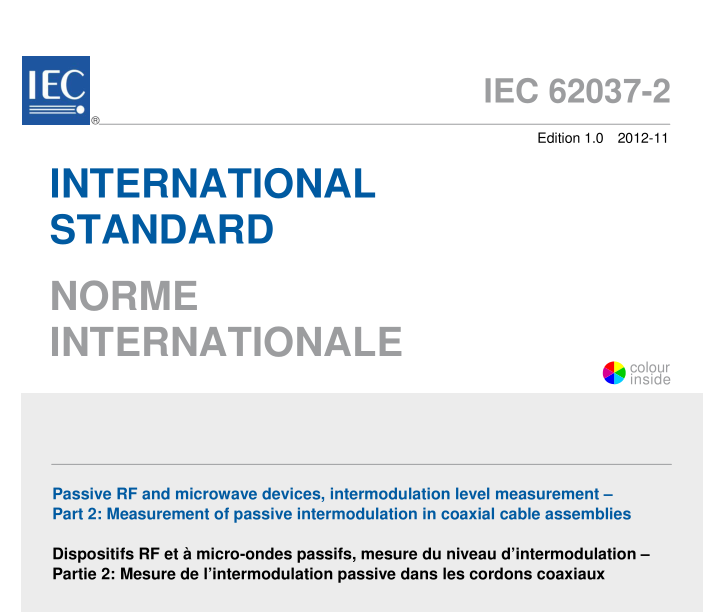IEC 62037-2:2012 pdfダウンロード

IEC 62037-2:2012 pdfダウンロード。Passive RF and microwave devices, intermodulation level measurement – Part 2: Measurement of passive intermodulation in coaxial cable assemblies
1 Scope
This part of IEC 62037 defines a procedure to measure levels of passive intermodulation generated by a coaxial cable assembly. This test method is applicable to jumper cables, i.e. cable assemblies intended to provide interface flexibility between rigid devices.
2 Normative references
The following documents, in whole or in part, are normatively referenced in this document and are indispensable for its application. For dated references, only the edition cited applies. For undated references, the latest edition of the referenced document (including any amendments) applies. IEC 62037-1 :201 2, Passive RF and microwave devices, intermodulation level measurement – Part 1: General requirements and measuring methods
3 Abbreviations
DUT Device under test PIM Passive intermodulation
4 Test set-up Set-up 1 and set-up 2 are applicable in this PIM-test. Either set-up 1 (reverse method, see 6.2.2 of IEC 62037-1 :201 2), or set-up 2 (forward method, see 6.2.3 of IEC 62037-1 :201 2), may be used for cable assemblies, provided that the attenuation of the assembly is not greater than 1 dB.
For higher attenuation, the reverse method shall be used. The connector under test should be clamped and mechanically secured to prevent its movement during the test.
A describable and repeatable mechanical stress is applied to the DUT. This mechanical stress is defined by a distance d, between the end of the cable-entry (the last rigid mechanical point of the connector) and the point of the deflection, and circular movement around the cable axis with a radius r.
This test shall be performed on each end independently. An example of a test set-up is shown in Figure 1 . The cable movement is depicted in Figure 2. The rotational radius (r) and distance (d) is defined in Table 1 . The cable attachment to the termination should be supported.
Other values may be used as specified by the customer and supplier or by the manufacturer.
The movement of the cable shall be carried out with a minimum of 3 cycles and a rate of (5 ± 2) s per revolution.
Torsion shall not be applied to the cable. It is recommended to rotate the cable clockwise.
5 Procedure
The procedure is as follows:
a) calibrate the set-up;
b) connect the DUT to the set-up;
c) read the PIM before applying mechanical stress;
d) apply mechanical stress to the DUT according to Table 1 ;
e) read the maximum PIM level while applying mechanical stress to the DUT;
NOTE If using a spectrum analyser, it is helpful to use the “max-hold” function.
f) stop the mechanical stress;
g) read the PIM level after applying mechanical stress.
6 Report
The report should include the following:
a) radius;
b) distance from the PIM tester;
c) PIM levels during rotation;
d) PIM levels after rotation.
- Previous:IEC 61097-6:2012 pdfダウンロード
- Next:IEC 62386-206:2009 pdfダウンロード